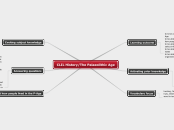CLIL History/The Palaeolithic Age
Learning outcome
to know about some aspects of life and art in the Palaeolithic Age
to be able to analyse historical sources in order to interpret how people lived
to be able to use ICT for historical enquiry: to gather and select information
to be able to transfer historical information from text to notes
to be able to create a fact file by locating, selecting and organising historical information
Activating prior knowledge
Project or copy and put up three images of life in the Palaeolithic Age: a stone tool; a pot; a cave painting.
Ask learners to tell you any word or phrase they associate with the images. For example: stone, very old, animal, cave, hunting animals, for water. Accept some L1 and translate. Write the words and phrases on the board. Ask learners to predict what they will learn about in the history lesson.
Write ‘Palaeolithic Age’ on the board and repeat the phrase several times. Mark the main stress by underlining ‘lith’. Find out if learners know the meaning of Palaeolithic (palaeo = ancient + lithos = stone) and tell them it is a Greek word. Ask them to guess what Neolithic means
(new stone). etc.
Vocabulary focus
hunting, fishing, gathering, nomadic, outdoors, caves, wood huts, tribes, fire on blackboard (students will reads these word in text)
Evoking subject knowledge
Learners first look at the picture of ‘Life in a cave’ and the caption below the picture (see following page). Elicit what they can see and ask them what they think people did during the Palaeolithic Age (question in Activity a). Identify the fire in the centre of the picture and ask why fire was an important discovery (question in Activity b). Provide language support by writing a sentence starter on the board: Fire was important because Palaeolithic people could _______________.
Answering questions
Learners read the text and notice the key vocabulary which was recorded on the board and which is written in bold font in the text. In pairs, learners then answer Activities a and b orally. Did they predict the answers correctly before they read the text? With a different partner, agree how Palaeolithic people could have made their stone tools. Write verbs and gap-fill sentences on the board for support:
found, cut, shaped, used, smoothed, sharpened
They might have __________ them near the caves. They could have ________ the stones.
Notice that the sentences involve communicating ideas about possibilities in the past. The language needed in order to do this is advanced so most learners will need support to say or write these sentences accurately.
Text about how people lived in the P-Age
working with text
